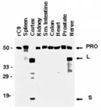Caspase 9 (CASP9) Rabbit Polyclonal Antibody
Frequently bought together (2)
Transient overexpression lysate of caspase 9, apoptosis-related cysteine peptidase (CASP9), transcript variant alpha
USD 436.00
Other products for "Caspase 9"
Specifications
| Product Data | |
| Applications | IHC, WB |
| Recommended Dilution | Immunocytochemistry/ Immunofluorescence, Immunohistochemistry, Immunoprecipitation: 1:50-1:200, Western Blot: 1:1000-1:2000, Immunohistochemistry-Paraffin: 1:1000-1:5000, Immunohistochemistry-Frozen, Simple Western: 1:200 |
| Reactivities | Human, Mouse, Rat, Canine, Gerbil |
| Host | Rabbit |
| Clonality | Polyclonal |
| Immunogen | Recombinant full-length human Caspase-9 protein (pro-form) was used as an immunogen (NP_001220). |
| Formulation | Store at -20C. Avoid freeze-thaw cycles. |
| Concentration | lot specific |
| Purification | Whole antisera |
| Conjugation | Unconjugated |
| Storage | Store at -20°C as received. |
| Stability | Stable for 12 months from date of receipt. |
| Predicted Protein Size | 46.3 kDa |
| Gene Name | caspase 9 |
| Database Link | |
| Background | Apoptosis, or programmed cell death, is a common property of all multicellular organisms. The current dogma of apoptosis suggests that the components of the core cell-death machinery are integral to cells and widely conserved across species. Caspases, a family of cysteinyl aspartate-specific proteases, are integral components of the cell death machinery (reviewed in Siegal, 2006; and Lavrik et al, 2005). They play a central role in the initiation and execution of apoptotic cell death and in inflammation. Caspases are typically divided into 3 major groups, depending on the structure of their prodomain and their function. Group 1: inflammatory caspases (caspases 1, 4, 5, 11, 12, 14). Group II: initiator of apoptosis caspases (caspases 2, 8, 9). Group II: effector caspases (caspases 3, 6, 7). Caspases are synthesized as zymogens (inactive pro enzyme precursors which require a biochemical change to become active enzymes) with an N-terminal prodomain of variable length followed by a large subunit (p20) and a small subunit (p10). Caspases are activated through proteolytic cleavage at specific asparagine residues that are located within the prodomain, the p10, and p20 subunits. Activation results in the generation of mature active caspases that consist of the heterotetramer p202-p102. Active caspases mediate cell death and inflammation through cleavage of particular cellular substrates that are involved in these processes. The Caspase-9 polyclonal antisera recognizes the proform of caspase-9 (approx. 50 kDa), and the large (approx. 35 kDa) and small (approx. 15 kDa) subunits of active/cleaved Caspase-9. |
| Synonyms | APAF-3; APAF3; ICE-LAP6; MCH6; PPP1R56 |
| Reference Data | |
| Protein Families | Druggable Genome, Protease, Stem cell - Pluripotency |
| Protein Pathways | Alzheimer's disease, Amyotrophic lateral sclerosis (ALS), Apoptosis, Colorectal cancer, Endometrial cancer, Huntington's disease, Non-small cell lung cancer, p53 signaling pathway, Pancreatic cancer, Parkinson's disease, Pathways in cancer, Prostate cancer, Small cell lung cancer, VEGF signaling pathway, Viral myocarditis |
Documents
| Product Manuals |
| FAQs |
| SDS |
{0} Product Review(s)
0 Product Review(s)
Submit review
Be the first one to submit a review
Product Citations
*Delivery time may vary from web posted schedule. Occasional delays may occur due to unforeseen
complexities in the preparation of your product. International customers may expect an additional 1-2 weeks
in shipping.






























































































































































































































































 Germany
Germany
 Japan
Japan
 United Kingdom
United Kingdom
 China
China





